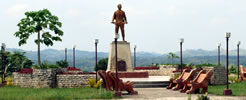 |
The Untold Story of Francisco Dagohoy By Chito Fuentes (Published in Inquirer on June 13, 1997) |
|||||||||
Ako si Franciso Dagohoy ang anak na maisog nga Bol-anon - Yoyoy Villame - |
||||||||||
The lines of this ditty about the fabled hero popularized by Boholano novelty singer Yoyoy Villame provides a stirring rendition of the greatest Boholano military strategist. And yet, aside from the generalization that are expected of a tribute, little else is known about Francisco Dagohoy the person. To a large extent. Villame's poverty of specifics reflect a greater injustice to one who led the most successful rebellion against Spanish rule that lasted 85 years. Dagohoy was Bohol's biggest contribution to the country's collection of military heroes but he had not been successful in drawing respect from his own people three generations later. His memorial marker was unveiled on April 11, 1955 by admirers led by then Vice President Carlos P. Garcia, one of Bohol's brightest sons. Today, it lies virtually nondescript in a bushy spot in Caylagan. Magtangtang. Danao town. A team of political science students from the University of Bohol led by class president Rey Rodriguez discovered to their dismay the Dagohoy Shrine desecrated by bounty hunters who damaged its surface for buried treasures. Rodriguez said the marker was nearly covered by overgrown bush. Lawyer Valeriano Vitor Jr., a native of Danao. said that aside from the impressive unveiling rites and subsequent visits by provincial officials, little attention has been given to Dagohoy's marker and heroism. Garcia even named the presidential plane after the military genius. Acknowledging the neglect Today, all that remains arc mementos often buried in the humdrum of existence. There is Camp Dagohoy. the seat of the Philippine National Police provincial command. "We acknowledge the centuries of neglect to his memory, which is the reason why we are starting to make amends." said Gov. Rene Relampagos. He said that as part of this year's "Sandugo" (blood compact) celebration, a musical titled "Dagohoy" will be presented. Not much is known of the man who enshrined himsclf in history. The only-available reference book devoted to him at the Bohol Provincial Library is "The Life and Struggle of Francisco Dagohoy: A Historical and Cultural Heritage to the Filipino People." written by Sotero Nurtez Misa. Misa's thesis, presented to the Graduate School faculty of the University of Bohol in October I970,. can very well be his greatest single contribution to Bohol and the country. Family roots Misa said there is no document available to shed light on Dagohoy's birth, his parentage and death. He believed this was due to the disinterest of Spanish authorities to record the hero's life and achievements and immortalize the exploits of one who so humiliated them. I Placido Sinsano, a centenarian , grandson of Dagohoy's brother and successor of Maximino, told Misa that Dagohoy was bom in 1724 in Cambito-on, a barrio of lnabanga town some 20 kilometers from the poblacion. Descendants claimed his father's name was Polon. probably Apolonio. while his mother's name was Sisa or Narcisa. Francisco was the second child in a family of three brothers and one sister Sagarino (the eldest and immediate cause of Francisco's rebellion), Maximino and Narcisa. The family's real surname is still uncertain to this day. Dagohoy was believed to be his nom de guerre when he was already leading the rebellion. A subsequent name adopted by some of his descendants. Sendrijas, has been considered as probable surname. Vitor. whose uncle, the late Danao Mayor Leopoldo Vitor, was considered among the most knowledgeable experts on Dagohoy, said Sendrijas may have been adopted by his family after the rebellion to protect them from the wrath of Spaniards sworn to annihilate the hero's memory. According to Misa, the Dagohoys were a model family in the community. They were devout Catholics, which can be borne out by the hiring of Sagarino. the eldest, by a Jesuit priest. Gaspar Morales, as sacristan and constable. The males engaged in farming and fishing, while the females wove blankets and mats made of buri palm. In his youth. Dagohoy showed athletic prowess, excelling in running, jumping, wrestling, fencing and dagger throwing when they were still in the mountain, and in boating and swimming when they moved near the coast. According to Misa, Dagohoy married Berinja Bugsok. a beautiful lass, during the early part of the rebellion. Unfortunately, the couple were childless. Berinja proved to be a perfect partner ably providing warmth and compassion that helped maintain her husband's good relationship with his followers. She accepted Dagohoy's sons by another woman, namely Hantud , Cawag , Boasa , Camangay and Estaca - and reared them as her own. Dagohoy was known as a great lover of animals. Gabriel Nipis, a descendant of Dagohoy's soldier Bartolome, was quoted by Misa as having described the hero's mountain capital and military headquarters as a "zoo." |
||||||||||
Please Like and share |
||||||||||
|
||||||||||
The Rebellion The immediate cause of the rebellion in 1744 was traced to Father Morales' refusal to give Christian burial to his brother Sagarino. In his book "Bohol and Its People," Cccilio Tutong said this ignited the Dagohoy Rebellion. Historian Gregorio Zaide said Morales sent out a native constable (Sagarino) to arrest a renegade Indian (for the pejorative word Indio ) who killed the former instead. Zaide said Father Morales refused to bury Sagarino in consecrated ground and the corpse laid unburied and rotting for three days. Because he died in a duel and, by the law of the church, he "did not merit a Christian burial." Angered by the injustice, Francisco swore vengeance on the Jesuit priest and persuaded the natives to join him. Some 3,000 followers abandoned their homes and fortified an inaccessible retreat in the mountains. On their way, they plundered San Xavier, a large estate belonging to the Jesuits, which was well stocked with cows, carabaos, horses and other animals. In Zaide's words, the rebellion rolled across the island "like horrendous cogon fires." Dagohoy, idolized as a liberator, emerged victorious on all fronts. His prestige "soared skyward" and his name "sped swiftly from coast to coast, from hill to hill, and from town to town." Military genius Dagohoy was an expert strategist who made full use of Ins familiarity with Danao's many caves and plunging cliffs. He had a knack for choosing appropriate names and sites. He established his headquarters in Cambito-on, a plateau named such because it is "near the stars." From there, Dagohoy had a commanding view of any approaching enemy force while being naturally protected by dangerous cliffs and rising hills. He could see as far as the skyline of Cebu and the island of Mactan and even a wonderful view of the Chocolate Hills. Vitor recalled stories handed down through generations about a watch tower on Tawagan Hill where the sentry calls out an alarm at the sight of approaching vessels from Cebu. He said Dagohoy also devised an effective relay system using native gongs. The presence of an approaching stranger was known to him hours before it reached the first outpost. A sitio of Cambito-on, aptly named Pasanan from the Cebuano word "pasa", served as relay point to Dagohoy. Barrio Taming (Visayan for shield), a plateau, provided the "shield" and guard post. Magtangtang got its name from the practicc of natives to untie their cargoes from the carabao's back for wallowing in the river. Dagohoy's offices were housed in Caylagan, a sitio of Magtangtang. It came as no surprise that Don Pedro Lechuga, the Spanish military commander in Bohol in 1747, found that Dagohoy was a master of guerrilla warfare. Supernatural powers Dagohoy was known for his pen-chant for anting-antings (amulets). This worked to his advantage as his followers eventually believed he possessed supernatural powers. On his neck hung a talisman which gave him "power" to appear and disappear. Stories abound about Dagohoy's ability to jump from one hilltop to another and from one side of the river. His followers eventually called him "dagangan" Dagang was the Visayan word for feathers, perhaps playing up his ability to glide among the hills The word Dagohoy itself is believed to be a mere contraction of two Visayan words: "dagon" and "hoyohoy." Dagon is a charm of magical power given to a good man by supernatural beings while hoyohoy referred to gentle breeze or wind. Dagohoy nurtured the image of a hero who had the magical power of gentle breeze, to float and disappear as he wished. Vitor said Dagohoy mastered the numerous caves and underground rivers in Magtangtang, which have remained mysterious and cryptical to this day. This baffled the enemy no end and to such an extent that even his followers heightened his mystic. Dagohoy lived till he was 101, dying probably in 1825. The rebellion which he led outlived him. valiantly carried on by his brother Maximino. better known as Tugpa. By the time the joint Filipino-Spanish troops commanded by Capt. Manuel Sanz crushed the rebellion in 1829. it was already 85 years old. It remains the highlight in the Philippines' struggle against Spanish colonization unmatched in durability. |
||||||||||
Please Like and share |
||||||||||
www.boholrealty.net copyright 2007-2016, All rights reserved |
||||||||||








